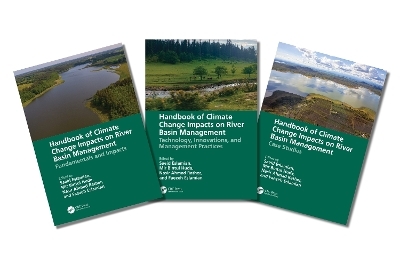
Handbook of Climate Change Impacts on River Basin Management, Three-Volume Set
CRC Press
9781032041551 (ISBN)
Climate change is an alarming issue that has affected the globe at multiple levels. It involves not only rising temperatures but also changes to the original hydro-meteorological parameters of a region and the corresponding changes emerging in the various biotic or abiotic environmental features.
Changing landscapes have become quite visible, and one of the prominent results of climate change has been the impact on the sediment yield and its transport. These changes have implications for various other environmental components, particularly soils, water bodies, water quality, land productivity, sedimentation processes, glacier dynamics, and risk management strategies to name a few. Understanding recent changes in sediment yield impacts due to changing climate will enhance the field of water resources management as well as land conservation techniques.
This handbook examines hydrology, watershed, soil erosion, global climate change scenarios, changing dynamics of streamflow and erosion, impact of changing sediment dynamics, major problems associated with change in the original sediment balance in nature, the latest computing technologies incorporated in the studies, risk control and management measures. It also includes case studies from various countries, which will help illustrate the problem of climate change, as well as introducing region-specific approaches.
Prof. Saeid Eslamian is a full professor of environmental hydrology and water resources engineering in the Department of Water Engineering at Isfahan University of Technology, where he has been since 1995. His research focuses mainly on statistical and environmental hydrology in a changing climate. In recent years, he has worked on modeling natural hazards, including floods, severe storms, wind, drought, pollution, water reuses, sustainable development and resiliency, etc. Formerly, he was a visiting professor at Princeton University, New Jersey, and the University of ETH Zurich, Switzerland. On the research side, he started a research partnership in 2014 with McGill University, Canada. He has contributed to more than 600 publications in journals, books, and technical reports. He is the founder and chief editor of both the International Journal of Hydrology Science and Technology (IJHST). Eslamian is now associate editor of three important publications: Journal of Hydrology, Eco-Hydrology and Hydrobiology, Journal of Water Reuse and Desalination (IWA) and Journal of the Saudi Society of Agricultural Sciences. Professor Eslamian is the author of more than 40 books and 200 chapter books. Dr. Mir Bintul Huda (B.Tech, M.Tech, AMIE, Ph.D.) is presently a Consultant at Water Resources Management Centre, National Institute of Technology Srinagar, Jammu & Kashmir. Her work is on Water Resources, Climate Change Impacts and adaptation of strategies with respect to Planning and Management of Water Resources Systems of Indus Basin. Dr. Mir received Ministry of Human Resources Development (MHRD) Doctoral fellowship from Government of India and earned her Doctorate in Civil Engineering with majors in Water Resources Engineering from National Institute of Technology Srinagar. She did her Masters of Technology in Water Resources Engineering from NIT Srinagar. She has done her Bachelors in Agricultural Engineering from Sher-e-Kashmir University of Agricultural Sciences and Technology, Kashmir (SKUAST-K). She is a Corporate Member of Institute of Engineers, India, Kolkata (IEI) and earned her AMIE in Civil Engineering. Her research interests comprise of Water Resources Engineering, Management and Hydraulic Structures. In addition to handling the project work she is actively involved in supervising Doctoral and Post-Graduate candidates in their R&D activities. She has many publications in reputed international journals to her credit and is associated with several academic societies. Dr. Nasir Ahmad Rather (B.E., M.Tech, Ph.D.) is an Assistant Professor of Civil Engineering at College of Engineering and Technology, Baba Ghulam Shah Badshah University, Rajouri, Jammu & Kashmir, India. In addition to conducting classes for the engineering students, he is actively involved in guiding the research projects. He is also part of many academic committees and administrative boards. Dr. Rather has Doctorate in Civil Engineering from National Institute of Technology Srinagar, Masters of Technology (M. Tech) in Water Resources Engineering from the National Institute of Technology Srinagar and Bachelors of Engineering (B.E.) in Civil Engineering from University of Kashmir, India. He received Ministry of Human Resources Development (MHRD) Doctoral Fellowship from Government of India. His research interests include Water Resources and Geo-technical Engineering, Protective Filters, Climate Change, Hydraulic Structures and River Engineering. He has numerous publications in international peer-reviewed journals of high impact. Dr. Rather is actively associated with different national and international societies and academies and gained recognition among the honorable subject experts with the contributions made. Dr. Faezeh Eslamian is a PhD Holder of Bioresources Engineering in McGill University. Her research focuses on the development of a novel lime-based product to mitigate phosphorus loss from agricultural fields. Faezeh completed her bachelor and master’s degrees in Civil and Environmental Engineering from Isfahan University of Technology, Iran where she evaluated natural and low-cost absorbents for the removal of pollutants such as textile dyes and heavy metals. Furthermore, she has conducted research on the worldwide water quality standards and wastewater reuse guidelines. Faezeh is an experienced multidisciplinary researcher with interest in soil and water quality, environmental remediation, water reuse and drought management.
VOLUME I. Part I: Soil Erosion, Sedimentation and Contaminants. 1. Sediment Impact on Flood-Spreading Projects. 2. Soil Erosion and Sediment Yield Modeling. 3. Sediment Transport in Urban Drainage Channels. 4. Effect of Contaminants in Irrigation Water on Soil and Groundwater Pollution. 5. Sediment Pollution and Global Warming. Part II: Rainfall-Runoff Modeling and Risk Management. 6. Hydrological Simulation of Rainfall-Runoff Modeling Based on ANFIS. 7. Runoff: Computation and Modeling. 8. A Review of Flood Risk Management Methods. Part III: Climate, Water and Society Interaction. 9. Climate and Society Interaction in Urban Watersheds. 10. Effect of Social Activities on Water Management with Emphasis On Water Users’ Cooperatives. Part IV: Climate Change Fundamentals. 11. Global Treaties and Policies on Climate Change and Water Resources. 12. Global Climate Change Vulnerabilities and Adaptation Scenarios. 13. Global Climate Modeling and Regional Climate Downscaling. 14. Dynamics of Watershed Processes in Light of Climate Change. 15. Sediment Yield and Discharge in the Changing Climatic Scenario. 16. Glacier Change, Glacial Lake Outburst Flood and Sediments in Changing Climate. Part V: Climate Change Impacts. 17. Introduction to Climate Change Impact on River Basin Management. 18. Impact of Changing Climate on the Streamflow. 19. A Global Perspective on Negative Impacts of Climate Change on Soil Erosion. 20. Impact of Climate Change on Sediment Load and Sediment Yield in Drainage Basins. 21. Impact of Changing Climate on the Land Use and Land Cover: An Overview. 22. Impact of Changing Climate on Land Use and Land Cover: A Comprehensive Review. 23. Impacts of Climate Change on Water and Food Security in River Basins: Need for Climate Smart Agriculture. 24. Impacts of Climate Change on the Quantity and Quality of Surface Water Resources.
VOLUME II. Part I: Software Technologies. 1. Predictive Modeling Trap Efficiency of Detention Dams using Soft-Computing. 2. Software Technologies for Studying Runoff and Sediment Yield. 3. Application of Soft-Computing in Sediment and Erosion Modelling. 4. MONITORING AND MAPPING OF WETLANDS USING GIS. 5. Estimation of Sub-basin Annual flow Using GIS. 6. Remote Sensing and Geographic Information Systems for River Management. 7. Potential impacts of climate change: Importance of Using GIS for its management. 8. Investigating the effects of agricultural management on wheat plant productivity gap using Aqua-Crop software. 9. Evaluating the Effect of Climate Change on Soil Erosion using Remote Sensing and Satellite Image Processing. 10. Markov Chain and Monte Carlo Methods: Application for Head Loss Determination. 11. Structuring of a Model for Risk Evaluation of Worker Exposure to Gypsum Dust. Part II: Management Practices. 12. Integrated Water Resources Management and Sediment. 13. Application of Mathematical Advances for Management of Groundwater Resources using Coastal Land Reclamation Considering the Climate Challenges by Sea Level Rise. 14. Soil Erosion Control. 15. Museum Emergency Management and Disaster Risk Reduction Strategies. 16. Irrigation for Soil Salinity Control. Part III: Recent Innovations. 17. Climate Adaptation and Water-Environment-Energy Nexus. 18. A Collective Voluntary Disaster Insurance Using the Property-Tax and Coverage of Low-Income People. 19. Transboundary Resilience and Social-Hydrological Systems. 20. Sustainable Green Buildings and Infrastructure for Climate Resilience. 21. Sedimentation, Erosion, and Resilience. 22. Consequences of Coastal Erosion, Displacement and Community Relocation. 23. Recent Progresses in Dam Reservoir Sediment Estimation and Control. 24. Bankfull Stage and Discharge : A Comprehensive Review.
VOLUME III. Part I: South and North America. 1. Watershed Management Case Studies in USA and Canada. 2. Sediment Yield in Extreme Cold Environments: The Case of the Sagavanirktok River in Arctic Alaska, USA. 3. Regional Precipitation and Streamflow Trends In the Bermejo River Basin in The Context of Global Change in Argentina. 4. Statistical Modelling of Summer Precipitation in the Pampa Region of Argentina. Part II: Africa. 5. Climate Change Impact on Sediment Yield Case Studies in Africa. 6. Basin Management Case Studies in North Africa. 7. Global Climate Change and Free Market Economy Double Exposure Influence on Co-operatives in Tanzania: Hopes and Fears. 8. Assessing Environmental Causes and Its Disaster Risk Management of Erosion in Agulu-Nanka Community. 9. Land Cover/Use Changes and Urban Flood Incidence in Osun River Basin, Southwest Nigeria. 10. Sediment Transport Index and Stream Power Index using GIS: A Case Study in Bou Saâda Wadi-Sub Basin, Algeria. 11. Hydrological Hazard and Climate Change in Arid and Semi-arid Regions. Part III: South Asia. 12. Climate Change Impacts on Water Resources and Sediment Yield in South Asia. 13. Detection of Land Surface Temperature in North West Part of Bangladesh: A Remote Sensing Based Approach. 14. Heavy Metals on the Sediments of Ship Breaking Zone and Impact on Fish Diversity in Coastal Bangladesh. 15. Environmental Impacts on Sediment Load and Bank Erosion in River Channels in Bangladesh. 16. Impact of Climate Change and Human Influence on the Sediment Yield of Indian Himalayan Rivers. Part IV: East Asia. 17. Impact of Large Dams on Local Climate Change: A Case Study on the Three Gorges Dam. 18. Historic Rainwater Harvesting System in Kampong Ayer (Water Village) in Brunei Darussalam. 19. Role of Wetlands in Flood Prevention in Brunei Darussalam: A Case Analysis on Tutong District. Part V: Middle East. 20. Projected Changes in Climate Extremes by High Resolution Regional Climate Model over Türkiye. 21. Time Series Analysis for Watershed Meteorological Data: A Case Study on Temperature Prediction. 22. Irrigation with Superabsorbent Polymer under Drought Stress Condition in a Temperate Arid Region. 23. Wind Drift and Evaporation Losses from Sprinkler Irrigation in a Semi-Arid Climate.
| Erscheint lt. Verlag | 29.8.2024 |
|---|---|
| Zusatzinfo | 187 Tables, black and white; 311 Illustrations, black and white |
| Verlagsort | London |
| Sprache | englisch |
| Maße | 178 x 254 mm |
| Gewicht | 2410 g |
| Themenwelt | Naturwissenschaften ► Geowissenschaften ► Geologie |
| Naturwissenschaften ► Geowissenschaften ► Hydrologie / Ozeanografie | |
| Technik ► Bauwesen | |
| Technik ► Umwelttechnik / Biotechnologie | |
| ISBN-13 | 9781032041551 / 9781032041551 |
| Zustand | Neuware |
| Informationen gemäß Produktsicherheitsverordnung (GPSR) | |
| Haben Sie eine Frage zum Produkt? |
aus dem Bereich
